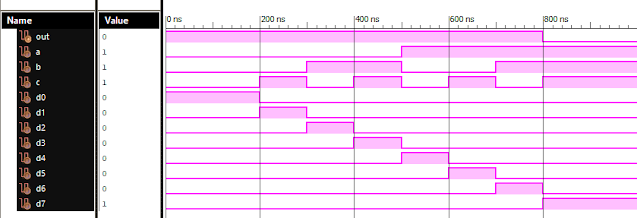Latest Post
Applied Instrumentation GTU (Sem-1) - ME Instrumentation and Control (IC)
- Get link
- X
- Other Apps
1. STUDY MATERIAL for Applied Instrumentation GTU (Sem-1) - ME Instrumentation and Control (IC)
- SEM 1:
Subjects: AIDC (Advanced Industrial Drives and Control)
ISC (Intelligent Systems and Control)
OTE (Optimization Techniques for Engineers)
ESI (Embedded System for Instrumentation)
IPR
Click on the below given links to download study material:
Syllabus
Books
Notes
Study Material
Lab Manual
Question Papers
Assignments
Sem 2: ME - Applied Instrumentation
Click on the below given link to download study material:
Subjects:
AVD (Advanced Verilog Design)
ISI (Intelligent Sensors and Instrumentation)
DC (Digital Control)
ASPE (Advanced Signal Processing and Estimation)
Disaster Management
Also See:
- Get link
- X
- Other Apps
Popular posts from this blog
Verilog: 8 to 1 Multiplexer (8-1 MUX) Dataflow Modelling with Testbench Code
Verilog Code for 8 to 1 Multiplexer Dataflow Modelling module mux_8to1( input a, input b, input c, input D0, input D1, input D2, input D3, input D4, input D5, input D6, input D7, output out, ); module m81( output out, input D0, D1, D2, D3, D4, D5, D6, D7, S0, S1, S2); assign S1bar=~S1; assign S0bar=~S0; assign S2bar=~S2; assign out = (D0 & S2bar & S1bar & S0bar) | (D1 & S2bar & S1bar & S0) | (D2 & S2bar & S1 & S0bar) + (D3 & S2bar & S1 & S0) + (D4 & S2 & S1bar & S0bar) + (D5 & S2 & S1bar & S0) + (D6 & S2 & S1 & S0bar) + (D7 & S2 & S1 & S0); endmodule //Testbench code for 8-1 MUX Dataflow Modelling initial begin // Initialize Inputs a= 0;b = 0;c = 0;D0 = 1;D1 = 0;D2 = 0;D3 = 0;D4 = 0;D5 = 0;D6 = 0;D7 = 0; // Wait 100 ns for global reset to finish #100; // Add stimulus here #100; a = 0;b = 0;c = 1;d0 = ...
VLSI: 1-4 DEMUX (Demultiplexer) Dataflow Modelling with Testbench
Verilog Code for 1-4 DEMUX Dataflow Modelling module demux_1_to_4( input d, input s0, input s1, output y0, output y1, output y2, output y3 ); assign s1n = ~ s1; assign s0n = ~ s0; assign y0 = d& s0n & s1n; assign y1 = d & s0 & s1n; assign y2 = d & s0n & s1; assign y3 = d & s0 & s1; endmodule //Testbench code for 1-4 DEMUX Dataflow Modelling initial begin // Initialize Inputs ...
VLSI: 4-1 MUX Dataflow Modelling with Testbench
Verilog Code for 4-1 MUX Dataflow Modelling module m41(out, i0, i1, i2, i3, s0, s1); output out; input i0, i1, i2, i3, s0, s1; assign y0 = (i0 & (~s0) & (~s1)); assign y1 = (i1 & (~s0) & s1); assign y2 = (i2 & s0 & (~s1)); assign y3 = (i3 & s0 & s1); assign out = (y0 | y1 | y2 | y3); endmodule //Testbench code for 4-1 MUX Dataflow Modelling initial begin // Initialize Inputs a = 1;b = 0;c = 0;d = 0;s0 = 0;s1 = 0; ...
Full Subtractor Verilog Code in Structural/Gate Level Modelling with Testbench
Verilog Code for Full Subtractor Structural/Gate Level Modelling module full_sub(borrow,diff,a,b,c); output borrow,diff; input a,b,c; wire w1,w4,w5,w6; xor (diff,a,b,c); not n1(w1,a); and a1(w4,w1,b); and a2(w5,w1,c); and a3(w6,b,c); or o1(borrow,w4,w5,w6); endmodule //Testbench code for Full Subtractor Structural/Gate Level Modelling initial begin // Initialize Inputs a = 0; b = 0; c = 0; // Wait 100 ns for global reset to finish #100; // Add stimulus here #100; a = 0;b = 0;c = 1; #100; a = 0;b = 1;c = 0; #100; a = 0;b = 1;c = 1; #100; a = 1;b = 0;c = 0; #100; a = 1;b = 0;c = 1; #100; a = 1;b = 1;c = 0; #100; a = 1;b = 1;c = 1; end Output: RTL Schematic: Full Subtractor Verilog Other Verilog Programs: Go to Index of Verilog Programming
VLSI: BCD to Excess 3 and Excess 3 to BCD Dataflow Modelling
module bcd_ex3_Dataflow( input a, input b, input c, input d, output w, output x, output y, output z ); assign w = (a | (b & c) | (b & d)); assign x = (((~b) & c) | ((~b) & d) | (b & (~c) & (~d))); assign y = ((c & d) | ((~c) & (~d))); assign z = ~d; endmodule Excess 3 to BCD: module ex3_to_bcd( input w, input x, input y, input z, output a, output b, output c, output d ); assign a = ((w & x) | (w & y & z)); assign b = (((~x) & (~y)) | ((~x) & (~z)) | (x & y & z)); assign c = (((~y) & z) | (y & (~z))); assign d = ~z; endmodule




Comments
Post a Comment